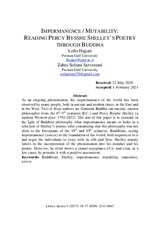Mostrar el registro sencillo del ítem
Impermanence / mutability: reading Percy Bysshe Shelley’s poetry through Buddha
| dc.contributor.author | Hajjari, Leila | |
| dc.contributor.author | Soltani Sarvestani, Zahra | |
| dc.date.accessioned | 2023-02-24T09:14:30Z | |
| dc.date.available | 2023-02-24T09:14:30Z | |
| dc.date.issued | 2017 | |
| dc.identifier.issn | 2341-0663 | |
| dc.identifier.uri | http://hdl.handle.net/10396/24779 | |
| dc.description.abstract | As an ongoing phenomenon, the impermanence of the world has been observed by many people, both in ancient and modern times, in the East and in the West. Two of these authors are Gautama Buddha (an ancient, eastern philosopher from the 6th-5th centuries B.C.) and Percy Bysshe Shelley (a modern Western poet: 1792-1822). The aim of this paper is to examine in the light of Buddhist philosophy what impermanence means or looks in a selection of Shelley’s poems, after considering that this philosophy was not alien to the Europeans of the 18th and 19th centuries. Buddhism, seeing impermanence (anicca) as the foundation of the world, both acquiesces to it and urges the individuals to sway with its ebb and flow. Shelley mainly falters in the incorporation of the phenomenon into his mindset and his poems. However, he often shows a casual acceptance of it; and even, in a few cases, he presents it with a positive assessment. | es_ES |
| dc.description.abstract | La transitoriedad del mundo ha sido considerada un concepto relevante por muchos autores antiguos y modernos, tanto en el este como en el oeste. Dos de estos autores son Gautama Buda (ss. VI-V a.C.) y Percy Bysshe Shelley (1792-1822), el primero perteneciente a la cultura oriental antigua y el segundo a la cultura occidental moderna. El propósito de este estudio es examinar, a la luz de la filosofía budista, qué significa y cómo se manifiesta el motivo de la transitoriedad en la poesía de Shelley, partiendo del hecho de que la filosofía del budismo se difundió en la Europa de los siglos XVIII y XIX. El budismo, considerando que la “impermanencia” o transitoriedad (anicca) es una de las tres marcas de la existencia, invita al individuo a aceptar y convivir con esa inestabilidad. Por su parte, Shelley adopta normalmente una actitud dudosa respecto a la incorporación de este fenómeno en su ideario y en su poesía. Se detecta, sin embargo, que a menudo muestra una aceptación casual del concepto. En unos pocos casos, incluso presenta una visión positiva del mismo. | es_ES |
| dc.format.mimetype | application/pdf | es_ES |
| dc.language.iso | eng | es_ES |
| dc.publisher | Cultural Association Littera Aperta | es_ES |
| dc.rights | http://creativecommons.org/licenses/by/4.0/es/ | es_ES |
| dc.source | Littera Aperta 05, 19-37 (2017) | es_ES |
| dc.subject | Buddhism | es_ES |
| dc.subject | Shelley | es_ES |
| dc.subject | Impermanence | es_ES |
| dc.subject | Mutability | es_ES |
| dc.subject | Transience | es_ES |
| dc.subject | Anicca | es_ES |
| dc.subject | Budismo | es_ES |
| dc.subject | Cambio | es_ES |
| dc.subject | Mutabilidad | es_ES |
| dc.subject | Transitoriedad | es_ES |
| dc.title | Impermanence / mutability: reading Percy Bysshe Shelley’s poetry through Buddha | es_ES |
| dc.title.alternative | Transitoriedad / mutabilidad: lectura de la poesía de Percy Bysshe Shelley a través de Buda | es_ES |
| dc.type | info:eu-repo/semantics/article | es_ES |
| dc.relation.publisherversion | https://www.uco.es/ucopress/ojs/index.php/litteraaperta/ | es_ES |
| dc.rights.accessRights | info:eu-repo/semantics/openAccess | es_ES |

